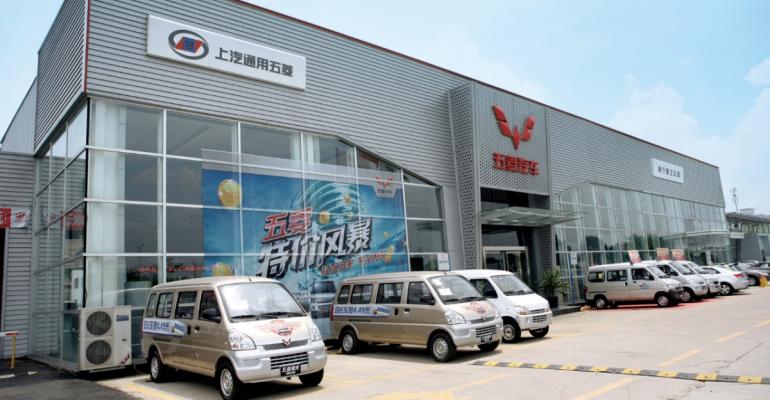BEIJING – For China’s auto dealers, the world used to be a bright and shiny place. New-car sales were growing by double digits annually. Dealers were flush with cash. Profits were healthy. Not anymore.
“China is changing from a seller’s to a buyer’s market,” Shen Jinjun, chairman of the China Automobile Dealers Assn., tells WardsAuto during an interview.
New-car sales in China are expected to grow at least 5% this year. But profit on those sales, already small, has vanished for many dealers. China’s retailers now are having to look to areas such as finance and insurance and used cars for profits. That will involve rebalancing their entire business model.
China’s dealers are too dependent on new-car sales. In 2014, the most recent year for which figures are available, new-car sales at China’s 100 strongest dealerships accounted for 39.4% of gross profits, according to CADA.
Parts and service are another huge profit center for Chinese dealerships. Though the segment may account for only 10% of a dealership’s income, it can account for 50% of total profit, Shen says.
That imbalance exists because until recently dealerships only could sell parts provided by manufacturers, and only repairs at dealerships were covered by the manufacturers’ warranties. Dealers passed on those high prices to consumers.
In 2014, China’s central government declared that setup illegal under the Anti-Monopoly Law. Dealerships now can sell third-party parts, and repairs by third parties soon may be covered by warranty.
“So the profit in this area won’t continue to be so high,” says Shen.
F&I, Used-Car Sales Ripe for Growth
However, two traditional profit sources for U.S. dealerships are ripe for growth in China: F&I and used-car sales.
In China, only 30% of consumers use financing to pay for new cars compared with more than 80% in the U.S. This is partly because Chinese typically have had an aversion to buying on credit, but that is changing; younger generations are more willing to finance all manner of purchases.
And sources of financing are expanding. Banks and automotive finance companies – which are joint ventures between automakers and Chinese financial institutions – have provided new-vehicle financing for several decades.
Third-party financiers also are growing. Ping An Bank, started by one of China’s largest non-state-owned insurance firms, is eager to expand its auto-financing business, Xu Zhengwu, vice president-Ping An Bank Financial Center Div., told attendees at the recent AutoHaus China International Dealer Summit in Beijing.
Financing can be an extremely rewarding business for dealerships, says Arlan Tarhan, president of Convergence Alliance, a Southern California-based dealership-development consultancy.
For example, “in Southern California, the F&I average on the back end on a new car is $1,200 to $1,300,” he says. “Dealers don’t make anywhere near that on selling the car.”
A better-developed auto-financing structure in China could help grow another untapped profit center for dealerships: leasing. The penetration rate for leasing in the country is less than 2%.
Chery He Changjin, general manager-All Trust Leasing, the leasing arm of Guanghui Group, China’s largest dealership group, tells the AutoHaus China conference he sees that changing fast.
“The younger generation in China is much more willing to take out loans,” says He. “They will become important consumers of auto finance” including leasing.
But CADA’s Shen sees a bigger problem for the future of leasing in China than an unwillingness to take out a loan: the lack of a good way to establish a residual value for used cars.
“That system still needs to be built,” he says.
Shen does see a lot of promise for dealerships in China’s used-car sector, however. The country’s used-car market is still small – fewer than 10 million units in 2015. But, fed by China’s robust new-car sales over the past six years, it is expected to exceed 10 million annually by 2017.
Also boosting the used-car market is a change in the segment’s image. A decade ago, a used car was seen as one that had been in an accident or had major mechanical problems, Kevin Huang, product manager-Used Car App Development at Piston Intelligence in Guangzhou.
“Now they have an image as an economical and practical choice of a tool,” he tells WardsAuto. “I guess the sales of used cars will see major growth in the coming five years.”
Ping An Bank is eager to provide financing for used-car sales, says Xu. “Secondhand car lending should be very hot,” he says.
In China, most used cars are sold through state-owned markets. Used-car sales accounted for a slim 1.8% of franchised-dealership gross profits in 2014.
Dealerships in China haven’t sold more used cars because they lacked the means to recondition the vehicles, and they were making a lot of money just by selling new cars, says Huang.
But profit margins on used cars can reach 15%, he says. “Since the profit margin of new cars is shrinking, there will be more and more new-car dealers starting to sell used cars,” he says.
A series of policies recently promulgated by China’s central government is aimed at growing the used-car market. Known as the “Eight Items,” the measures include simplifying the used-car registration process, boosting support for used-car loans and encouraging the development of used-car dealership groups.
“In the next two years, the secondhand car market will really take off,” predicts CADA’s Shen.





